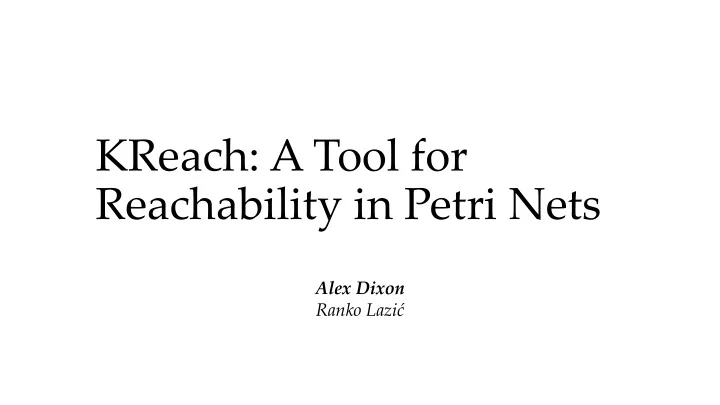

KReach: A Tool for Reachability in Petri Nets Alex Dixon Ranko Lazić
The Reachability Problem INPUT: • Petri net N = ( P, T ) • Initial marking 𝑛 𝑗 • Target marking 𝑛 𝑢 OUTPUT: • Reachable if 𝑛 𝑗 𝑛 𝑢 in 𝑶 • NotReachable otherwise
Complexity • Lower bound – Not Elementary [1] • Upper bound - Ackermannian [2] • Coverability is EXPSPACE-Complete [3] [1] Czerwinski et al., STOC 2019 [2] Leroux & Schmitz, LICS 2019 [3] Rackoff, TCS 1978
Kosaraju’s Algorithm [4] • Builds on the work of Mayr, Sacerdote, Tenney • Is a complete algorithm for deciding reachability • Can be implemented and tested (this work) [4] Kosaraju, STOC 1982
The algorithm, quickly • Search • Through the space of decompositions • Decompositions are computed using a structural predicate called the 𝜄 condition • Eventually: • We find a decomposition that fulfils 𝜄 (Reachable! ☺ ) • We exhaust the tree (Not reachable. )
The Tool Available at: https://github.com/dixonary/kosaraju Implemented in the Haskell programming language Related VASS programming libraries: https://github.com/dixonary/vass https://github.com/dixonary/karp-miller
Results
Parameterised Results 𝑢 1 [0, −𝑌] The program ran in exponential time in z3, but cvc4 remained linear (time to check satisfiability of 𝜄 is linear in X)
Coverability → Reachability Reachability problems are hard to come by Reduction from coverability: we can cover 𝑛 in some net iff we can reach 0 in a modified version of the same net => We can test the reachability decision procedure using coverability benchmarks from the literature
The fast and the curious Notably, KReach was able to rule out coverability on some safe Petri nets as fast, or faster, than several leading coverability solvers. KReach was able to rule out coverability based on few decompositions. Instances which required a lot of decomposition took much longer to evaluate with KReach than other tools. * Within the given time and memory constraints [4GB, 1hr]
Recommend
More recommend